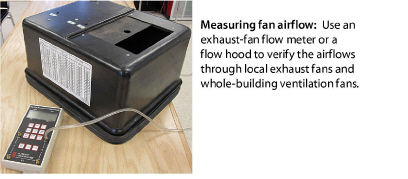
9.2 ASHRAE Standard 62.2–2016 Ventilation
|
SWS Details: 6.6201.2 Primary Ventilation Air Flow between Rooms |
Most dwellings in North America currently rely on air leakage for ventilation. The American Society of Heating, Refrigerating, and Air Conditioning Engineers (ASHRAE) publishes ventilation standards for dwellings.
Their current standard, ASHRAE 62.2–2016, defines the roles and minimum requirements for mechanical and natural ventilation systems and the building envelope. The roles and requirements intend to provide acceptable indoor air quality in residential buildings.
9.2.1 ASHRAE 62.2–2016 Components
If you air-seal dwellings during weatherization, you may need to install whole-dwelling mechanical ventilation systems under ASHRAE 62.2–2016, which has 3 components.
1. Whole-dwelling ventilation.
2. Local ventilation.
3. Natural infiltration credit.
This ventilation standard allows for natural infiltration (air leakage) to contribute toward the required whole-dwelling ventilation rate for single-family homes and horizontally attached multifamily buildings (but not vertically attached multifamily buildings.
9.2.2 Whole-Dwelling Ventilation Requirement
To comply with ASHRAE 62.2–2016, use either the formula or the table shown here to determine the whole-dwelling ventilation airflow requirement.
You can provide this mechanical airflow in 4 ways.
1. A dedicated exhaust or supply fan running continuously or cycling by automatic control.
2. A bathroom or kitchen exhaust fan running continuously or cycling by automatic control.
3. A central air handler drawing filtered outdoor air into its return.
4. A balanced ventilation system such as a heat-recovery ventilator (HRV) or energy-recovery-ventilator (ERV).
Room Pressure Imbalances
If any room in the building exceeds ±3 pascals pressure with reference to the common area when all interior doors are closed and while the ventilation system is operating, take action to reduce the pressure. Install transfer grilles or jumper ducts as needed to reduce the room to common area pressure difference to less than ±3 pascals. SWS Detail: 6.6201.2 Primary Ventilation Air Flow between Rooms
Option 1: Finding the Airflow Requirement Using the Formula
If you want to install the minimum ventilation capacity, use these 3 steps to follow the formula option.
1. Determine the floor area of the conditioned space of the home in square feet (Afloor).
2. Determine the number of bedrooms (Nbr).
3. Insert these numbers in the formula shown next.

Option 2: Finding the Airflow Requirement Using the Table
Note: If you know the number of occupants, compare the number of occupants with the number of bedrooms plus 1 and use the higher of those two values.
You can also determine the required continuous fan airflow under ASHRAE 62.2–2016 using the table shown here.
|
Floor Area (ft2) |
Number of Bedrooms |
||||
|
1 |
2- |
3 |
4 |
5 |
|
|
30 |
38 |
45 |
53 |
60 |
|
|
501-1000 |
45 |
53 |
60 |
68 |
75 |
|
1001-1500 |
60 |
68 |
75 |
83 |
90 |
|
1501-2000 |
75 |
83 |
90 |
98 |
105 |
|
2001-2500 |
90 |
98 |
105 |
113 |
120 |
|
2501-3000 |
105 |
113 |
120 |
128 |
135 |
|
3001-3500 |
120 |
128 |
135 |
143 |
150 |
|
3501-4000 |
135 |
143 |
150 |
158 |
165 |
|
4001-4500 |
150 |
158 |
165 |
173 |
180 |
|
4501-5000 |
165 |
173 |
180 |
188 |
195 |
|
From ASHRAE Standard 62.2-2016 |
|||||
Additional Ventilation Guidance
If the ventilation airflow requirement is less than 15 CFM, ASHRAE 62.2–2016 exempts the mechanical-ventilation requirement.
Residential Energy Dynamics provides a free online tool to help calculate ASHRAE 62.2–2016 ventilation rates.
Refer to the ASHRAE standard for more details, guidance, and exceptions that are beyond the scope of this field guide.
9.2.3 Local Exhaust Ventilation Requirement
|
SWS Detail: 6.6002.3 Exhaust-Only Ventilation—Fan Intake Grille Location, 6.6003.3 Through the Wall, 6.6005.2 Kitchen Range |
There are two options for complying with the local ventilation requirements for kitchens and bathroom: demand-controlled exhaust or continuous exhaust.
1. For demand-controlled exhaust specify a minimum of 100 CFM for the kitchen, and 50 CFM for each bathroom. An operable window reduces a bathroom’s ventilation requirement to 30 CFM.
2. For continuous exhaust specify a minimum of 20 CFM for each bathroom, and 5 ACH for the kitchen (based on volume).
Local Exhaust Deficit
If the existing kitchen or bathroom ventilation doesn’t meet the requirements stated here, you may adjust the whole-dwelling ventilation rate to compensate for the local airflow deficits. Follow these steps to calculate the local-ventilation deficit in CFM that must be added to the whole-dwelling ventilation rate.
1. Determine the total local exhaust ventilation requirement for all kitchens and bathrooms.
2. Measure the delivered airflow of existing kitchen or bathroom exhaust fans using flow hood, flow grid, or other airflow measuring device. Subtract this amount from the total local exhaust ventilation requirement.
3. If the local jurisdiction allows for operable windows to provide for local ventilation, subtract 20 CFM for each kitchen or bathroom that has an operable window.
The result of these steps is the local exhaust ventilation deficit in CFM. Add 1/4 of this deficit to the required whole-dwelling ventilation rate.

ASHRAE 62.2–2016 allows for infiltration to contribute to the dwelling’s ventilation airflow. Infiltration can supply the entire whole-dwelling ventilation requirement for very leaky buildings. For moderately leaky buildings, infiltration may supply some of the building’s ventilation.
Both single-family and multifamily buildings that are horizontally attached (low rise) are eligible for the infiltration credit.
You can determine the amount of the infiltration credit with a blower door test and weather data based on the building’s location. Calculating the infiltration credit without software is complicated. To simplify the calculations, use the RED Calc Free online tool and select “yes” for the “Use the infiltration credit” option.